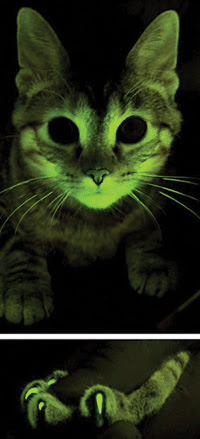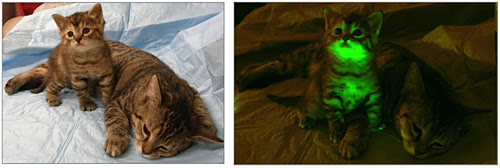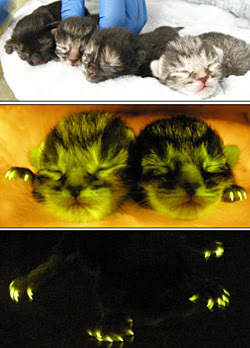
Fluorescing Felines Fight AIDS
ROCHESTER, Minn., Sept. 12, 2011 —  In new biomedical research aimed at benefiting both human and feline health, cats have been genetically engineered with rhesus monkey proteins that resist feline immunodeficiency virus, which is similar to the human immunodeficiency virus (HIV), a precursor to AIDS. The addition of fluorescent jellyfish proteins gives virologists and others the ability to study the effects of AIDS-protection genes and track their progression in animals vulnerable to the virus.
In new biomedical research aimed at benefiting both human and feline health, cats have been genetically engineered with rhesus monkey proteins that resist feline immunodeficiency virus, which is similar to the human immunodeficiency virus (HIV), a precursor to AIDS. The addition of fluorescent jellyfish proteins gives virologists and others the ability to study the effects of AIDS-protection genes and track their progression in animals vulnerable to the virus.
A cat with genes for a jellyfish fluorescent protein, which produces the green color, as well as an antiviral restriction factor from a rhesus macaque. Coat, claws, whiskers, nose, tongue and the inside of the mouth glow green under blue light; fluorescence is quenched in dark fur. (Images: Mayo Clinic)
Mayo Clinic researchers and physicians, along with virologists, veterinarians, gene therapy researchers and collaborators in Japan, devised a way to insert macaque monkey proteins that block the virus into feline eggs (oocytes) before they are fertilized — a technique called gamete-targeted lentiviral transgenesis. To track the protein, the researchers added a fluorescing jellyfish gene that makes the eventual offspring glow green under certain light.
“This provides the unprecedented capability to study the effects of giving AIDS-protection genes into an AIDS-vulnerable animal,” Dr. Eric Poeschla of the Mayo Clinic, who led the study, told Reuters in a telephone interview. He said that cats and, to some extent, chimpanzees are the only mammals besides people that develop a naturally occurring virus that causes AIDS. “One of the best things about this biomedical research is that it is aimed at benefiting both human and feline health,” he said.

A 1-month-old kitten that has genes from a jellyfish fluorescent protein and a rhesus macaque (a virus-blocking restriction factor, TRIMCyp) is shown next to a sleeping adult control cat (who seems unimpressed). Both are tabby-coated and look the same under regular light.
Both HIV and FIV work by wiping out the infection-fighting T-cells. Proteins called restriction factors, which normally fight off viral infections, are defenseless against HIV and FIV because the viruses have evolved potent counterweapons. For the researchers, the trick was to get the monkey gene for the restriction factor known as TRIMCyp into cats to block cells from becoming infected with the virus. To date, AIDS has killed nearly 30 million people worldwide, and it is estimated that the same number of people are currently living with HIV.

Germline transmission: mating between a transgenic sire and queen produced these healthy kittens that also have the genes and make the proteins. Dark fur quenches such that in the black cat, only claws are abundantly fluorescent.
According to the team, the method for inserting genes into the feline genome is highly efficient, so that virtually all offspring have the genes; what’s more, the defense proteins are made throughout the cat’s body. The cats with the protective genes are thriving and have produced kittens whose cells make the proteins, thus proving that the inserted genes remain active in successive generations.
So far, the team has only tested cells taken from the animals that were found to be resistant to FIV, but eventually the researchers plan to carry out in vivo studies, exposing the cats to the virus to see whether they are, in fact, protected. Researchers say the results would provide a lot of information about protecting humans from HIV.
The study was published in the online issue of Nature Methods.
For more information, visit: www.mayo.edu
Published: September 2011